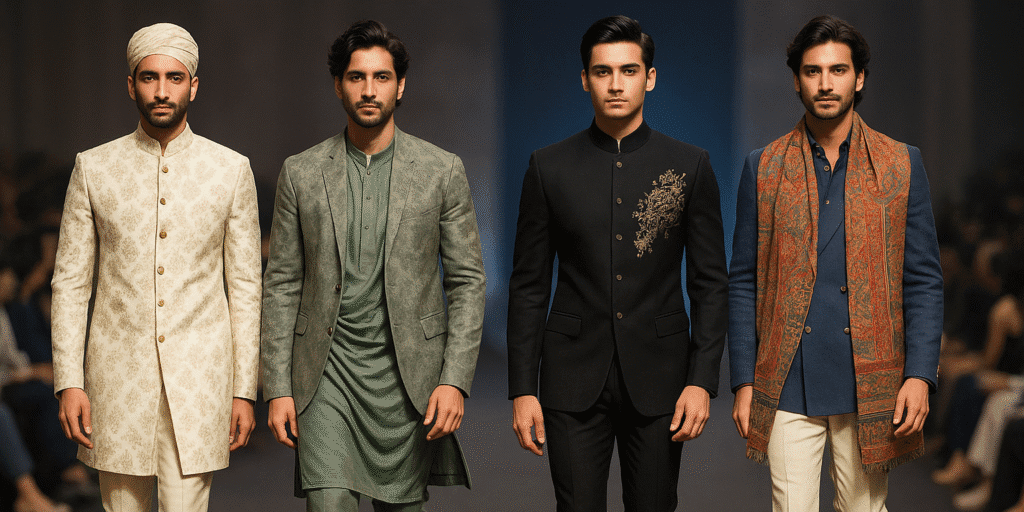The Fashion Design Council of India (FDCI) concluded its second annual Men’s Fashion Week on February 4, 2024, with a two-day event that not only elevated the profile of Indian menswear but also reaffirmed the country’s growing influence on the global fashion stage. Held at the atmospheric Aguad Port and Jail Complex in Goa, the venue itself—rich in colonial history and heritage—mirrored the thematic undercurrents of the collections presented: a dialogue between the past and present, between nostalgia and innovation.
An Ensemble of Iconic Designers
The runway showcased collections from some of India’s most esteemed designers, including Abhishek Gupta, Abraham & Thakore, and JJ Valaya, each bringing a distinct voice to the narrative of contemporary Indian menswear. Their collections embodied a powerful synthesis of traditional craftsmanship and forward-thinking design, staying true to the roots of Indian textiles and artisanal techniques while pushing boundaries with silhouettes, styling, and themes.
Abhishek Gupta focused on structured tailoring fused with handcrafted embellishments, while Abraham & Thakore, known for their minimalist aesthetic, introduced reimagined versions of Indian staples like the kurta and bandhgalas with subtle Western tailoring influences. Meanwhile, JJ Valaya, the master of regal opulence, brought grandeur to the stage with elaborately embroidered jackets, silk trousers, and layered sherwanis inspired by Mughal and Rajput heritage—reinvented for modern, cosmopolitan wearers.
From Vintage Americana to “Eclectic Grandpa” Aesthetic
One of the standout trends from this year’s FDCI showcase was the surprising infusion of vintage Americana and the increasingly popular “eclectic grandpa” style—a nod to global trends currently dominating the menswear scene. Designers worked these themes into their collections with patterned knitwear, high-waisted pleated trousers, and accessories like berets, oversized glasses, and tweed bags, lending the runway a whimsical, retro edge.
This aesthetic juxtaposed beautifully with more formal, Indo-Western garments, demonstrating how Indian fashion is adept at borrowing from global influences without losing its indigenous character. The results were ensembles that spoke to nostalgia—invoking the image of an Indian gentleman from the 1950s or 60s—but styled in a way that would feel equally at home in fashion capitals like Milan or Paris.
A Platform for Cultural Storytelling
The selection of Goa’s Aguad Port and Jail Complex as the venue added deeper cultural texture to the event. The aged stone walls and sea breeze lent a sense of rootedness, anchoring the runway in history even as the designs ventured into the future. This historic backdrop provided a rich setting for what FDCI intended to be more than just a fashion showcase—it was a celebration of identity, craftsmanship, and cross-cultural conversation.
FDCI President Sunil Sethi remarked during the closing ceremony that this year’s event was not only larger in scale but more deliberate in intent. “We want the world to understand that Indian menswear is no longer niche—it is dynamic, trend-aware, and globally relevant while remaining deeply personal and artisanal,” he said.
The Future of Indian Menswear
As the curtains closed on the February 2024 edition of FDCI Men’s Fashion Week, the message was clear: Indian menswear is experiencing a renaissance. It is unafraid to experiment, to blend the rich visual lexicon of the subcontinent with international style narratives. This openness—paired with deep-rooted craftsmanship—positions India as a rising force in men’s global fashion.
Whether it’s the resurgence of old-world silhouettes, handwoven textiles reinterpreted for modern wardrobes, or the quiet charm of a knitted vest worn under a bandhgala, the Indian fashion scene is embracing the new with reverence for the old. As global fashion increasingly looks eastward for inspiration, India stands poised to lead, not follow.
